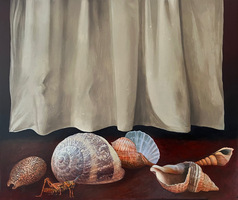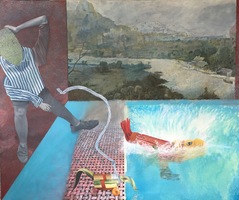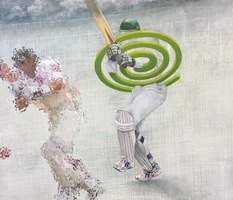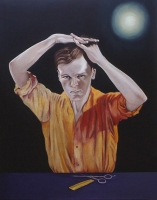The 'Insect' series of paintings and assemblages has been made possible through the generous support of the Stiftung Kunstfonds, Germany.
The works in this series are inspired by a variety of insects and by the environmental changes decimating their existence,
By combining changes of scale from nano through to landscape I am exploring the structural and textural qualities and the complexity, delicacy and vulnerability of insect life forms.
The works in this series are inspired by a variety of insects and by the environmental changes decimating their existence,
By combining changes of scale from nano through to landscape I am exploring the structural and textural qualities and the complexity, delicacy and vulnerability of insect life forms.
Household Pets in a Digital World
Squeaky colored pool toys in front of Himalayan peaks, animal bodies made of pots and pans, people with giraffe necks and binocular eyes - it is a surreal world into which Christopher Croft's paintings entice the viewer. But these paintings point with force and at the same time with poetry to very real threats to the world in which we live: from environmental pollution and overproduction, to alienation, dehumanization and the dominance of the modern West over the Old East.
The Australian artist's most recent series comprises six large-format paintings with six preparatory drawings. It bears the title: Household Pets in a Digital World. Christopher Croft had the initial idea for this in a Parisian park, where he was fascinated to observe how the animals displayed there fashionably matched their owners. He transformed the park scenes into the digital world in which everything flows and everything seems possible. There, the figures, painted with captivating precision, are assembled using the "copy & paste" system - as a hotchpotch world in which unity and order no longer prevail. They appear disconnected from reality, groundless, and thus devoid of responsibility.Squeaky colored pool toys in front of Himalayan peaks, animal bodies made of pots and pans, people with giraffe necks and binocular eyes - it is a surreal world into which Christopher Croft's paintings entice the viewer. But these paintings point with force and at the same time with poetry to very real threats to the world in which we live: from environmental pollution and overproduction, to alienation, dehumanization and the dominance of the modern West over the Old East.
It is not an optimistic view that Christopher Croft takes of the world, but an enlightening one, and in the details often a very humorous and warm-hearted one. The high-contrast images are full of quotations and allusions - to Pieter Brueghel, to Edvard Munch, to Alexander von Humboldt. It is a series that may seem like a riddle at first glance. But on closer looking, the great stories that each of these pictures has to tell are revealed.
Dr.Peter Münch
"One study estimated the particulate matter produced from burning one mosquito coil was equivalent to burning 75-137 cigarettes. This amount of exposure poses a health risk, but there is a lack of clear evidence that the long-term exposure to mosquito coil smoke increases the risk of more serious health impacts such as lung cancer. In the face of this uncertainty, the key message should be to avoid prolonged exposure, especially in enclosed spaces."
https://theconversation.com/are-mosquito-coils-good-or-bad-for-our-health-88548
Artist's note:
Any resemblance between the mosquito coil's shape and the Milky Way's elegant, spiral structure is purely coincidental. Nor were any animals harmed during the painting of this series.
https://theconversation.com/are-mosquito-coils-good-or-bad-for-our-health-88548
Artist's note:
Any resemblance between the mosquito coil's shape and the Milky Way's elegant, spiral structure is purely coincidental. Nor were any animals harmed during the painting of this series.
Small Windows
Altogether, there are twenty-four paintings in the series (not all shown here). They were painted over a period of six years.
The images themselves are journal-like, inspired by objects from my immediate surroundings at the time. There is no particular narrative or theme: they are simply fragments from my everyday life.
I began the “Small Windows” series in London in 2011. I had just finished the "Doorwedge Chronicles" http://www.christophercroft.com/collages/doorwedge-chronicles which are tiny collages on wood panels. I was actually thinking about scale and painting some small works that looked (in reproduction) like much larger images.
Each of the little wooden panels measures 18 x 20 centimetres. The proportion of 9 to 10 seemed to work well as either a horizontal or a vertical format. I enjoyed the process of making the panels myself and preparing the painting surfaces with the acrylic ‘gesso’. Each of the wooden panels has five coats of gesso. After each coating was dry I sanded the brush strokes flat with fine sandpaper. The final coat was polished to give a smooth surface. When they were finally prepared, they felt like precious objects. It seemed appropriate to invest a concentrated effort into the consequent painting of each image.
I called the series “Small Windows” because, well firstly, they’re not miniatures but they are rather small. Secondly, 'windows' because each painting is a framed, close-up view on part of a much larger world.
Altogether, there are twenty-four paintings in the series (not all shown here). They were painted over a period of six years.
The images themselves are journal-like, inspired by objects from my immediate surroundings at the time. There is no particular narrative or theme: they are simply fragments from my everyday life.
I began the “Small Windows” series in London in 2011. I had just finished the "Doorwedge Chronicles" http://www.christophercroft.com/collages/doorwedge-chronicles which are tiny collages on wood panels. I was actually thinking about scale and painting some small works that looked (in reproduction) like much larger images.
Each of the little wooden panels measures 18 x 20 centimetres. The proportion of 9 to 10 seemed to work well as either a horizontal or a vertical format. I enjoyed the process of making the panels myself and preparing the painting surfaces with the acrylic ‘gesso’. Each of the wooden panels has five coats of gesso. After each coating was dry I sanded the brush strokes flat with fine sandpaper. The final coat was polished to give a smooth surface. When they were finally prepared, they felt like precious objects. It seemed appropriate to invest a concentrated effort into the consequent painting of each image.
I called the series “Small Windows” because, well firstly, they’re not miniatures but they are rather small. Secondly, 'windows' because each painting is a framed, close-up view on part of a much larger world.
The museum paintings are part of a series of works depicting people, animals and cultural fragments in a narrative setting.









